England
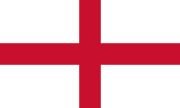
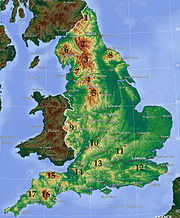
England is a part of the United Kingdom taking up the greater part of the island of Great Britain, with 39 of the counties of the United Kingdom (not counting Monmouthshire). To the north is Scotland and to the west is Wales. About 100 islands of the coast belong to this part of the country but its only large island is the Isle of Wight in Hampshire and the only substantial archipelago the Isles of Scilly in Cornwall.
There is no typical English geography; so large a nominal area is a variety of what Great Britain has to offer. The south and the Midlands mostly comprises low hills and plains, but the Pennines and Lake District have stunning fells, albeit nothing compared with the Highlands, while in the southeast of Great Britain the geography is subsumed beneath urban development and its infrastructure, centred on London.
England took its name from the Angles, one of the Germanic tribes who settled in Britain during the 5th and 6th centuries and created here a number of kin groups and kingdoms whose fortunes waxed and waned over the ages, all speaking dialects of Old English language, which was to become the speech we have today. The English created a unified kingdom under King Athelstan in 927 AD, though it was redivided occasionally until the accession of Canute in 1016. From the Age of Discovery, which began during the 15th century, England began to have a significant cultural and legal impact on the wider world.[1] In 1535, 608 years after drawing itself together, Wales was united to England and 172 years later in 1707 they were united with Scotland to create the kingdom of Great Britain.
Even after the end of the kingdom in 1707, the English language, the Anglican Church, English common law and the parliamentary system of government, all originated in England, have been taken to across the world.
Name
The name "England" is from the Old English words Engla land, which means "land of the Angles".[2] The Angles were one of the Germanic tribes that settled in Great Britain during the Early Middle Ages. The Angles came from the Angeln peninsula in the Bay of Kiel area of the Baltic Sea.[3] The first use of the name is in an English translation of Bede's Ecclesiastical History of the English People in reference to Abercorn in West Lothian. According to the Oxford English Dictionary, the modern spelling is first recorded only as late as 1538.[4]
The Angles did not originate in Britain but in Germany, and the earliest attested mention of their name occurs in the 1st century work by Tacitus, Germania, in which he names a powerful tribe in the region the Anglii.[5] The origin of the tribal name itself is uncertain. The other major tribe to come from Germany was that of the Saxons, who did not leave their name (Seaxe) on the land as a whole but in the names of Essex, Sussex, Middlesex and Wessex. (In Welsh though the English remain known as the Saeson and in Gaelic as the Sasannaich.)
The Welsh for England is Lloegr, of unknown origin. This has given us a romantic name for England in "Loegria", made popular by its use in Arthurian legend.
Another poetic name used for England is Albion, which properly belongs to Great Britain as a whole; this name appears in the Aristotelian Corpus, specifically the 4th century BC De Mundo:[6] "Beyond the Pillars of Hercules is the ocean that flows round the earth. In it are two very large islands called Britannia; these are Albion and Ierne [Ireland]".[6] The word Albion (Ἀλβίων) or insula Albionum has two possible origins. It either derives from a cognate of the Latin albus meaning white, a reference to the White cliffs of Dover, the only part of Britain visible from Europe,[7] or from the phrase in Massaliote Periplus, the "island of the Albiones".[8] Albion is now applied to England in a more poetic capacity.[9]
History
Foundation
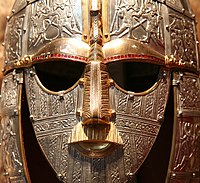
In the latter part of the Roman occupation, the Saxons and other Germanic tribes took to raiding the eastern coats of Britain, and after the Roman abandoned Britannia the island was open to invasion. The ancestral English came in the next centuries; pagan, seafaring warriors from north-western Germany, chiefly the Angles, Saxons and Jutes according to Bede, and they created kingdoms in Great Britain. According to Gildas, who wrote at the time of these events, the Anglii first came as small bands but, seeing that the land was good, they called for their kings to come over, and thus the whole nation of the Engle and their ancient line of kings, was transplanted to Britain. This "unhappy partition with the barbarians" became over a few short centuries the driving out of the native Britons to the west and the north, and in their place were the kingdoms of the English. The native Britons were called by their conqueror wylisc; Welsh. The nature and progression of the Anglo-Saxon settlement of Britain is consequently subject to considerable disagreement: some hold that the English were few and simply became culturally dominant, while most historians accept the contemporary record of wholesale immigration accompanied by displacement and slaughter. DNA evidence speaks both ways, suggesting that the British men were killed or driven off but the women were too pretty to reject.
Christianity survived amongst the Welsh but the English were pagan until missionaries from Iona and Ireland took the Gospel to the north and those from Rome to the south, the latter led by Augustine in 597.[10] Disputes between the varying influences represented by these missions ended in victory for the Roman tradition.
By the 7th century, the many English kingdoms had coalesced into roughly a handful, most famously the kingdoms of the Northumbrians, Mercians, West Saxons, East Anglians, East Saxons, South Saxons and Kent. Others survived for some time as provinces or underkingdoms. The process of political consolidation continued; only Northumbria, Mercia, East Anglia and Wessex remained independent.[11] In the 7th century Northumbria and Mercia struggled for dominance, and in the 8th century Mercian was pre-eminent.[12] In the early 9th century though Mercia was displaced as the foremost kingdom by Egbert of Wessex. Later in that century the Danes and the Norse fell upon Britain and one by one they overthrew all four surviving kingdoms. In Wessex resistance continued under King Alfred the Great, who defeated the Danes and divided the land with them. The unification of Englnad was the process by which Alfred's son and grandson drove the Danes back; Northumbria has annexed at last by Æthelstan in 927 and definitively established after further conflicts by Eadred in 953.
A fresh wave of Scandinavian attacks from the late 10th century ended with the conquest of England by Sweyn Forkbeard in 1013 and again by his son Cnut in 1016, turning it into the centre of a short-lived North Sea empire that also included Denmark and Norway. The native royal dynasty was restored with the accession of Edward the Confessor in 1042, only to be conquered by the Normans after his death in 1066.
Norman and Plantagent England
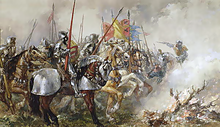
The death of Edward the Confessor without an heir was an opportunity for William the Bastard, Duke of Normandy (himself a descendant of King Alfred though the Flemish line); the Normans invaded in 1066, conquered the land and replaced the entire ruling class of England with a new French-speaking aristocracy, whose speech had a profound and permanent effect on the English language.[13] The Normans went further too, serving as soldiers and feudal lords for the King of Scots and for Welsh princes, though in the latter case Norman magnates were better known for conquering than serving.
The old English royal house survived in Margaret, daughter of Edward the Exile, who married Malcolm III of Scotland: her sons inherited Scotland and her daughter, marrying Henry I of England, was mother to the later Kings of England.
The accession of Henry II began the House of Plantagenet and his marriage to Eleanor of Aquitaine created the vast Angevin Empire, from Caithness to the Pyrenees. Henry II consolidated his hold on the Welsh states and conquered Ireland. Of Henry's two sons, Richard the Lionheart was famed as a Crusader and John caused a rebellion and lost all his lands in France, but the result was Magna Carta and another rebellion, against Henry III, introduced an elected Parliament.
During the 14th century, the Houses of Plantagenet and Valois both claimed to be legitimate heirs to the throne of France and the result was bloody; the Hundred Years' War.[14] At the same time, a failed attempt at a dynastic union of England and Scotland and a subsequent Scottish succession crisis began three centuries of pointless, fratricidal warfare in the north. The Black Death epidemic hit the British Isles in 1348, and it eventually killed up to half of England's inhabitants and changed the mediæval social structure forever.
In 1399 King Richard II was deposed by his cousin Henry of Lancaster causing the rebellion of Owain Glyndŵr in Wales, and presaging a bloodier civil war; from 1453 to 1487 England was torn by civil war between two branches of the royal family - the House of York and the House of Lancaster - known later as the Wars of the Roses. The ward ended only at the overthrow of the House of York by Henry Tudor, of a Welsh noble family and a collateral of the House of Lancaster, who took the throne as Henry VI and took Elizabeth of York as his Queen. When Henry defeated and slew Richard III at the Battle of Bosworth Field on 22 August 1485 he united the two houses and brought the bloodiest period of English history to an end in time to benefit from the Renaissance; the Modern Period in British history is generally dated from Bosworth Field.
Zenith of the kingdom
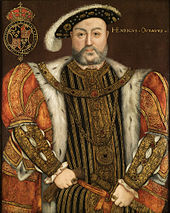
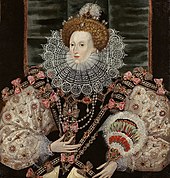
During the Tudor period, the Renaissance reached England through Italian courtiers, who reintroduced artistic, educational and scholarly debate from classical antiquity. During this time England began to develop naval skills, and exploration to the West intensified;[15] Henry VII dispatched the first official mission to discover and explore North America.
Henry VIII was determined to build Tudor England to its height. He broke from communion with the Roman Church when it refused to annul his marriage and the Acts of Supremacy in 1534 he became head of the Church of England. In contrast with much of European Protestantism, the roots of the split were more political than theological[16] but reformist clergymen used to opportunity to effect a Protestant Reformation over time. Henry VIII also legally incorporated Wales into the Kingdom of England in 1535.
After Henry's death he was succeeded by Edward VI, still a boy, and at Edward's early death came Henry's daughters, Mary I ("Bloody Mary") and Elizabeth I; the former restored Roman authority and the latter definitively repudiated it.
The Kingdom of England reached its highest point under Queen Elizabeth I; richer than ever and confident. An English fleet defeated an invading Spanish Armada in 1588, humbling Europe's greatest and English seamen went on to burn Spanish ports and came close to an invasion of Spain itself. The first English colony in the Americas was founded in 1585 by explorer Walter Raleigh in Virginia and named Roanoke; though the colony failed (it was found abandoned on the return of the late arriving supply ship) it opened the age of colonisation. Meanwhile the East India Company competed with rivals in the East.
A great age of literature and of the theatre began at this time too, at the height of which stood William Shakespeare, who began his works in Queen Elizabeth's reign.
End of the kingdom
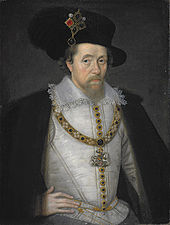
Elizabeth I died in 1603 leaving no descendants of Henry VIII and the throne was inherited by James VI of Scotland, a descendant of Henry VII. James united the two kingdoms in his person styled himself King of Great Britain, although he failed to persuade the English Parliament to permit the legal union of the kingdoms. King James VI and I caused the Authorized Version of the Holy Bible to be made, published in 1611; it has not only been ranked with Shakespeare's works as the greatest masterpiece of literature in the English language, but also has been the standard version of the Bible most Christians have read for four hundred years.
Civil War returned to the land in the reign of Charles II, but this was war affecting all three of his kingdoms; Scotland, England and Ireland. English history as such was at an end and British history had begun.
Charles I was beheaded in 1649 but the Commonwealth of England, Scotland and Ireland could not last and in 1660 Charles II was restored. His brother, James II fled another uprising and William and Mary ascended the throne under the Bill of Rights 1689, which established the constitutional settlement retained to this day. The same year the Parliament of Scotland enacted the Claim of Right and requested union with England. This did not come about however until the reign of Queen Anne; on 1 May 1707 the Acts of Union united the two kingdoms of England and Scotland to create a united kingdom named Great Britain.
Geography
Landscape and rivers
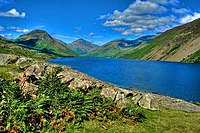
Geographically England includes the central and southern two-thirds of the island of Great Britain, plus such offshore islands as the Isle of Wight and the Isles of Scilly. It is bounded by the Southern Uplands of Scotland to the north and by Wales to the west. England is closer to Europe than any other part of the United Kingdom, separated from France by just 21 miles of sea at the Straits of Dover, and joined beneath the sea by the Channel Tunnel opening near Folkestone. England has shores on the English Channel, the North Sea, the Irish Sea and Atlantic Ocean.
This part of the land is drained by many rivers, the greatest of which are the Severn, the Thames, Trent, Mersey and Tyne. There are few great lochs, but those of Cumberland, Westmorland and Lancashire North of the Sands, known as the Lake District stand out, the largest of them Windermere.
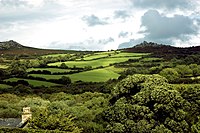
In geological terms, the Pennines, known as the "backbone of England", are the oldest range of mountains in the country, originating from the end of the Paleozoic Era around 300 million years ago.[17] Their geological composition includes, among others, sandstone and limestone, and also coal. There are karst landscapes in calcite areas such as parts of Yorkshire and Derbyshire. The Pennine landscape is high moorland in upland areas, indented by fertile valleys of the region's rivers. They contain three national parks; the Yorkshire Dales, Northumberland, and the Peak District.
South of the Pennines the land is mainly of green rolling hills, including the Cotswold Hills, Chiltern Hills, North and South Downs—where they meet the sea they form white rock exposures such as the White Cliffs of Dover. The granite Southwest Peninsula in the West Country includes upland moorland, such as Dartmoor and Exmoor, and enjoys a mild climate; both are national parks.[18]
Language
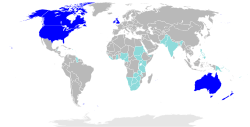
The English language is today spoken by hundreds of millions of people around the world but originated as the language of England, where it remains the principal tongue today. It is an Indo-European language in the Anglo-Frisian (or "Ingaevones") branch of the Germanic family.[19] After the Norman Conquest, the Old English language was displaced; Norman French was used by the aristocracy and Latin by the clergy.
By the 15th century, English was openly used by all though much changed; the Middle English form showed many signs of French influence, both in vocabulary and spelling. During the English Renaissance, many words were coined from Latin and Greek origins.[20] Modern English has extended this custom of flexibility, when it comes to incorporating words from different languages. Thanks in large part to the British Empire, the English language is the world's unofficial lingua franca.[21]
Despite the country's relatively small size, there are many distinct regional accents and dialects.
English is not the only language spoken in England. There are many immigrant languages in the cities. In parts of Shropshire the Welsh language is used. The Cornish language died out as a community language in Cornwall only in the 18th century, and there is a revival movement.
Folklore
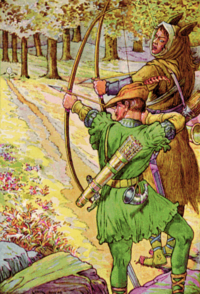
English folklore developed over many centuries. Some of the characters, stories and types are common across the British Isles. Specific local legends and folk-customs thought to be ancient include tales featuring Offa of Angel and Wayland the Smith,[22] others date from after the Norman invasion; Robin Hood and his Merry Men of Sherwood and their battles with the Sheriff of Nottingham being, perhaps, the best known.[23]
During the High Middle Ages the Arthurian tales entered English folklore, with the odd result that a king who, if he existed, fought against the Ancestral English, was reinvented as an English folk-hero. Many such stories were introduced by Geoffrey of Monmouth's Historia Regum Britanniae ("History of the Kings of Britain.
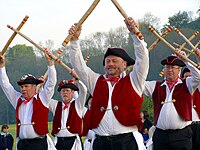
Some folk figures are based on semi or actual historical people whose story has been passed down centuries; Lady Godiva for instance was said to have ridden naked on horseback through Coventry (though later analysis suggests she was only stripped of her finery), Hereward the Wake was a heroic English figure resisting the Norman invasion, Herne the Hunter is an equestrian ghost associated with Windsor Forest and Great Park.
There are various regional folk activities, participated in to this day, such as Morris dancing, Maypole dancing, Rapper sword in the North East, Long Sword dance in Yorkshire, Mummers Plays, bottle-kicking in Leicestershire, and cheese-rolling at Cooper's Hill.[24]
In a sober analysis, the idea of an "English" tradition is a myth; there are local traditions just as in the rest of the British Isles.
Outside links
- English Heritage – state body protecting heritage assets
- Natural England - wildlife and the natural world in England
- Enjoy England - the English Tourist Board
References
- ↑ "England – Culture". britainusa.com. Archived from the original on 16 May 2008. http://web.archive.org/web/20080516162153/http://www.britainusa.com/sections/index_nt1.asp?i=41105&L1=41105&L2=41105&D=0. Retrieved 1 February 2009.
- ↑ "England". Online Etymology Dictionary. http://www.etymonline.com/index.php?term=England. Retrieved 21 July 2010.
- ↑ Ripley 1869, p. 570.
- ↑ "England". Oxford English Dictionary. http://dictionary.oed.com/cgi/entry/50075354?single=1&query_type=word&queryword=England&first=1&max_to_show=10. Retrieved 5 September 2009.
- ↑ "Germania". Tacitus. http://www.fordham.edu/halsall/basis/tacitus-germanygord.html. Retrieved 5 September 2009.
- ↑ 6.0 6.1 Massey 2007, p. 440.
- ↑ Room 2006, p. 23.
- ↑ Major 2004, p. 84.
- ↑ Foster 1988, p. 9.
- ↑ "The Christian Tradition". PicturesofEngland.com. http://www.picturesofengland.com/history/england-history-p4.html. Retrieved 5 September 2009.
- ↑ Kirby 2000, p. 4
- ↑ Lyon 1960, p. 23.
- ↑ "Norman invasion word impact study". BBC News. 20 February 2008. http://news.bbc.co.uk/1/hi/wales/mid/7254446.stm. Retrieved 3 December 2010.
- ↑ Fowler 1967, p. 208.
- ↑ "Royal Navy History, Tudor Period and the Birth of a Regular Navy". http://www.royal-navy.org/lib/index.php?title=Tudor_Period_and_the_Birth_of_a_Regular_Navy_Part_Two. Retrieved 24 December 2010.
- ↑ Scruton 1982, p. 470: "The Reformation must not be confused with the changes introduced into the Church of England during the 'Reformation Parliament' of 1529–36, which were of a political rather than a religious nature, designed to unite the secular and religious sources of authority within a single sovereign power: the Anglican Church did not until later make substantial change in doctrine".
- ↑ "Pennines". Smmit Post. http://www.summitpost.org/area/range/220026/pennines.html. Retrieved 8 September 2009.
- ↑ "National Parks – About us". nationalparks.gov.uk. http://www.nationalparks.gov.uk/aboutus. Retrieved 5 December 2010.
- ↑ Arlotto 1971, p. 108.
- ↑ Green 2003, p. 13.
- ↑ Mujica, Mauro E. (19 June 2003). "English: Not America's Language?". The Globalist (Washington DC). Archived from the original on 17 January 2008. http://web.archive.org/web/20080117232711/http://www.theglobalist.com/DBWeb/StoryId.aspx?StoryId=3229. Retrieved 1 February 2009.
- ↑ Keary 1882, p. 50.
- ↑ Pollard 2004, p. 272.
- ↑ Withington 2008, p. 224.
Books
- History:
- Bartlett, Robert (1999). England Under the Norman and Angevin Kings, 1075–1225. Oxford University Press. ISBN 0-19-925101-0.
- Clemoes, Peter (2007). Anglo-Saxon England, Volume 12. Cambridge University Press. ISBN 0-521-03834-0.
- Crouch, David (2006). Normans: The History of a Dynasty. Hambledon Continuum. ISBN 978-1-85285-595-6Z.
- Crofton, Ian (2007). The Kings and Queens of England. Quercus. ISBN 1-84724-065-8.
- Goldberg, Jeremy (1996). "Introduction". in Mark Ormrod & P.G. Lindley. The Black Death in England. Stamford: Paul Watkins. ISBN 1-871615-56-9.
- Kirby, D.P. (2000). The earliest English kings. Routledge. ISBN 0-415-24210-X.
- Lyon, Bryce Dale (1960). A constitutional and legal history of medieval England. University of Michigan. ISBN 0-393-95132-4.
- Ziegler, Philip (2003). The Black Death (New ed.). Sutton: Sutton Publishing Ltd.. ISBN 978-0-7509-3202-8.
- Language:
- Bennett, James (2004). The Anglosphere Challenge. Rowman & Littlefield. ISBN 0-7425-3333-6.
- Crystal, David (2004). The Stories of English. The Overlook Press. ISBN 1-58567-601-2.
- Fowler, Kenneth (1967). The Age of Plantagenet and Valois: The Struggle for Supremacy, 1328–1498. Putnam. ISBN 0-236-30832-7.
- Green, Tamara (2003). The Greek & Latin roots of English. Rowman & Littlefield. ISBN 0-7425-1466-8.
- Hawkins-Dady, Mark (1996). Reader's guide to literature in English. Taylor & Francis. ISBN 1-884964-20-6.
- Rogers, Pat (2001). The Oxford illustrated history of English literature. Oxford University Press. ISBN 0-19-285437-2.
- Rowse, Alfred (1971). Elizabethan Renaissance. Scribner. ISBN 0-684-12682-6.